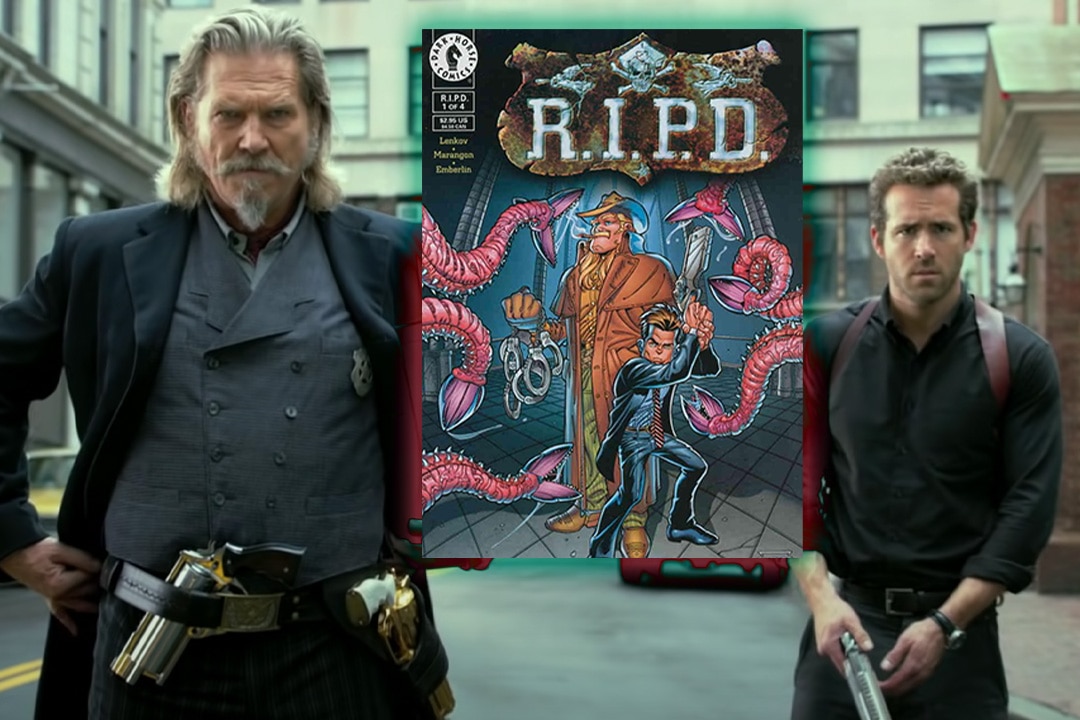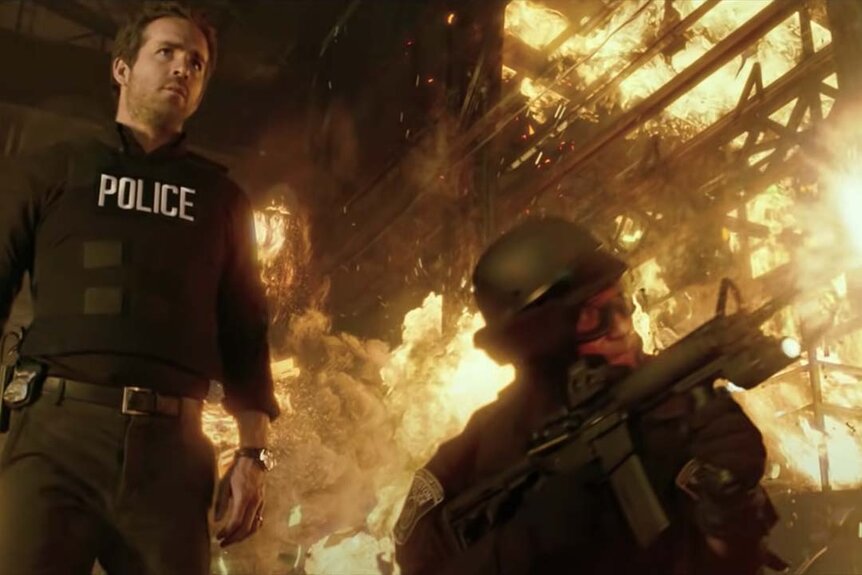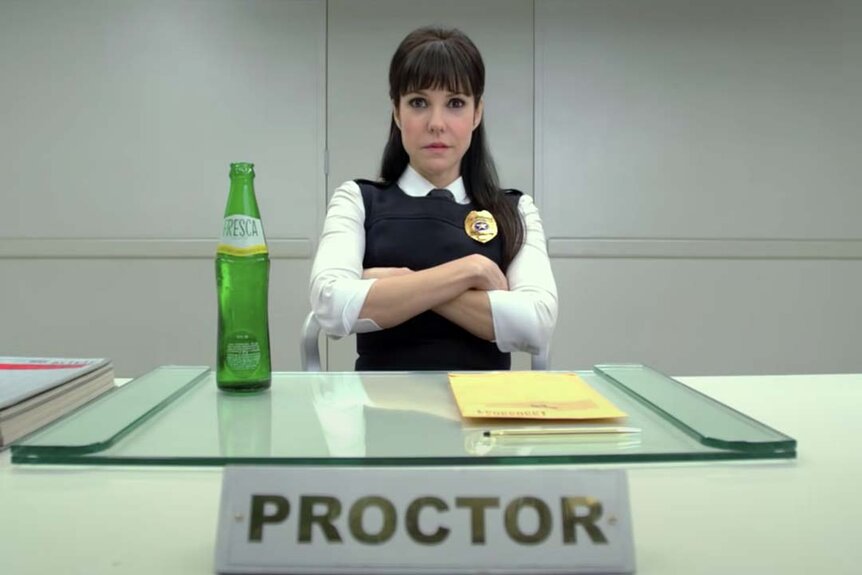Create a free profile to get unlimited access to exclusive videos, sweepstakes, and more!
R.I.P.D. Creators Talk Abandoned Franchise, Surprise Prequel & Resurrection Hopes
Peter Lenkov and Lucas Marangon on the origins of the R.I.P.D. comic book and how it became a major Hollywood adaptation.

When there's something strange in the afterlife, who ya gonna call? The Rest in Peace Department, of course! But that name might not be immediately recognizable to the average mortal on the street, despite the fact that it took prominent placement in a major Hollywood tentpole 12 summers ago.
Based on the 4-issue comic of the same name that Dark Horse published between late 1999 and early 2000, R.I.P.D. (now streaming on Peacock) centers around a paranormal police force comprised of the greatest law enforcement officers who ever lived… and died. The organization has only one goal: apprehend "Deados" — aka wayward and rotting souls lingering on Earth — and either send them to the underworld for a life sentence or, if they resist eternal damnation, erase them from the very fabric of the universe.
Ryan Reynolds leads the Men in Black meets Ghostbusters project as Nick Walker, a Boston cop shot down in the line of duty by his corrupt partner (Kevin Bacon). Rather than take his chances with cosmic judgement — after all, he was pocketing valuable evidence before his untimely demise — Nick agrees to a century of duty to the R.I.P.D. and finds himself partnered up with Roy Pulsipher (a delightfully scene-chewing Jeff Bridges), a rootin-tootin' Deado-huntin’ cowboy sheriff plucked straight out of the Old West.
While the movie is decidedly a buddy comedy with a genre slant on the mismatched cop formula, the source material by writer Peter Lenkov and artist Lucas Marangon carries a little more of a paranormal bite. In the comic, for instance, R.I.P.D. officers are allowed to avenge their deaths in exchange for 100 years of service. What's more: The two main characters (named Nick Cruz and Roy Powell) come face-to-face with a multitude of demons and even the Devil Himself.
Origins of the R.I.P.D. comic book
By Lenkov's rough estimate, the origin of the R.I.P.D. comic goes back 30 years. He came up with the idea while under contract as a writer for Universal Pictures. "I had the art department over there do a badge that had a crack in it and it said ‘R.I.P.D. Rest in Peace Department," he tells SYFY WIRE on zoom.
But since he didn't have the bandwidth to pitch the concept to the studio, he decided to hand it off to Terry Black, older brother of Shane Black. Terry seemed perfectly-suited to the material, having written the screenplay for 1988's Dead Heat, which centered around a resurrected cop, Roger Mortis (the late Treat Williams), hunting down other members of the undead.
"He came back and pitched a version of the movie that I didn't think was right for us," Lenkov remembers. "He's a great writer, but I didn't think it was the right tone of what I had in mind." And so, he decided to write it himself as a spec script that never materialized. But like departed souls wandering this mortal plane, the idea refused to move on. "It always nagged me."
While meeting with Dark Horse founder and CEO Mike Richardson "about something else," Lenkov proposed turning R.I.P.D. into a comic that could later serve as "proof of concept" for a feature film (à la Cowboys & Aliens and Oblivion).
"I think [it was] probably better for the project to have done it as a comic book first, just to figure out if it works," he concedes. "And as a writer, I love doing a comic book, because you can do anything in a comic book that you can't necessarily do in a movie."
Dark Horse then tapped Mexico-based artist Lucas Marangon to handle the interiors. This proved to be a major victory for the illustrator, who, up until that point, had been hawking his portfolio at comic book conventions, "secretly hoping that Dark Horse would pick it up," because the publisher enjoyed licenses to "all these amazing IPs that I was interested in such as Star Wars and other science fiction stuff," he admits on a separate Zoom call. "I had my own ideas book, I wanted the character to be some sort of Latino Brad Pitt from Se7en. But those ideas were coming up as I was going along."
"Lucas really stood out to me," Lenkov adds. "I liked the style and I liked the edge that he brought to his work and, ultimately, our panels. There was a grittiness that I responded to."
Given that this was his first major contract in the United States, Marangon wanted to prove he could play in "the big leagues" after cutting his teeth on "very trashy, very raunchy" pocket comic books, whose publishers placed almost no emphasis on quality (the turnover, he reveals, was approximately 80 pages in 15 days).
"It took me a while to turn the pages over [for R.I.P.D.] and maybe they got mad at me, but that was because I was trying to do my very best. When I was doing the little pocket books, the best you can do is irrelevant."
Throughout a "very lengthy design phase" funneled through editor David Land, he and Lenkov came up with the look of everything — from the R.I.P.D.'s firearms ("something godly, but at the same time, something that was organic"), to the viscera required for a story about the deceased coming back to life. "I learned to draw internal organs and dead people with that book."
How R.I.P.D. became a major Hollywood adaptation
The comic's high concept premise was just too good for Hollywood to pass up, with Universal scooping up the feature-length rights as part of a multi-year production deal with Dark Horse.
"It was Men in Black in Heaven and Hell ... the characters had a lot going on for them, so I was sure that it would be done sooner or later," Marangon says.
"I never thought of it like that," insists Lenkov. "I liked Men in Black, but I didn't like it [to the point] where I wanted to replicate that tone or concept." He did write an early version of the script, one he describes as "a little more grounded" and "a little edgier" than the lighter, MiB-style buddy comedy (with just a little bit of Ghost thrown into the mix) conceived by the two writers who replaced him: Ride Along duo Phil Hay and Matt Manfredi.
"Sometimes you just hang on for dear life when these things leave the gate," adds Lenkov, who received an executive producer credit. Beyond viewing a modicum of previz work and dailies, though, he didn't have much to do with production. "It really was the director whose vision made it to screen."
Speaking of, Wedding Crashers' David Dobkin initially signed on to direct, but was eventually replaced by Robert Schwentke, who proved himself capable of conjuring comic-to-film box office success with 2010's Red.
In terms of casting, Zach Galifianakis had originally been chosen to play Roy Pulsipher. The Hangover vet had to bow out of the project due to scheduling conflicts in April 2011 (Bridges nabbed the part about a month later).
As for the role of Nick Walker, Lenkov alleges that there was some "some remote interest" from Tom Cruise. "I knew that was never gonna happen, but everybody was floating that idea," he says. "But it just never materialized." Ryan Reynolds signed on to play Walker in Spring 2009 (via Variety).
When did R.I.P.D. open in theaters?
R.I.P.D. opened in theaters on July 19, 2013. Despite a novel concept and more-than-game cast (with Bridges being singled out by reviewers as the the obvious standout), the film failed to reach heavenly heights.
"I wanted it to be a big movie, but I wanted it to have a little more edge and really be connected to Hell, and escaping from Hell," says Lenkov, noting that the comic "leaned more towards horror than comedy."
It opened to a rather disappointing $12.8 million domestically, bested by another supernatural release, James Wan's The Conjuring, which debuted to $41.5 million in North America and spawned an entire franchise that continues to this day. When the dust had settled, R.I.P.D. entered the post-theatrical afterlife with a little over $78 million worldwide against a whopping price tag of $130 million.
Plans for a franchise were quickly dropped, which came as quite a blow to Lenkov, who had hoped for sequels featuring "different partnerships — whether it was a cop from the Al Capone days in Chicago partnered up with somebody from the Miami Vice days."
"So if you had a Don Johnson-type character, who did a cameo in the movie, that character — if [they were] played by Brad Pitt or whatever — would have his own movie down the road," he continues. "Now, that's big ideas and big dreams. It didn't happen, but that's what I had hoped for when it came to R.I.P.D."
What is the R.I.P.D. prequel Rise of the Damned?
R.I.P.D. must have "found an audience" on home video and/or streaming, Lenkov muses, because Universal's direct-to-video arm, 1440 Entertainment, reached out years later in the hopes of resurrecting the property.
The end result was R.I.P.D. 2: Rise of the Damned, though the "2" is kind of a misnomer since the resultant project (now on Netflix) is actually a prequel exploring how Roy Pulsipher (Jeffrey Donovan) joined the spiritual police force.
Paul Leyden (Cleaners) directed it, working off a screenplay loosely based on the official tie-in prequel Lenkov wrote in the run-up to R.I.P.D.'s theatrical release (subtitled City of the Damned, it featured artwork by Jeremy Barlow). Andrew Klein, who had worked on the Lenkov-developed reboot of MacGyver at CBS, penned the initial draft of the script before it was subsequently rewritten by Leyden.
Lenkov served as an executive producer on Rise of the Damned, but similar to his involvement on the first movie, he opted for a more hands-off approach. "Mike and I always felt that if we were getting somebody that was really passionate about the material, then we’d give them the room to do their job."
Will R.I.P.D. be rebooted as a film or television series?
For years now, Lenkov has attempted to convince Dark Horse and Universal to consider rebooting R.I.P.D. as a television show — not a bad idea, considering the success of SYFY's Resident Alien — that leans into his original "edgier" vision.
"I'm still hoping I could somehow convince everybody to do it as a series one day, because I think the concept is bigger than a movie," Lenkov explains. "I think in order to create the world, it needs a bigger canvas and as a series, it could do really well. But I would start from scratch. I would change the tone [and] everything. I wouldn't follow the movies that exist now. I would try to reinvent it."
When we ask him to elaborate on what a reinvention would entail, Lenkov compares his small screen ambitions to that of The Exorcist, specifically how the 1973 film tempered its overtly supernatural elements in "the real world."
"You believe it, even though somebody's floating and has the Devil spewing words out of their mouth. You believe it because it's all rooted in faith, in belief, in, the Bible," he emphasizes. "I would want to do a version of this where you can almost believe it exists, that this world exists — we just can't see it."
Will R.I.P.D. continue as a comic book?
It could happen! With all film and television development currently in limbo amidst the WGA and SAG-AFTRA strikes, Lenkov isn't opposed to revisiting R.I.P.D. in its comic book form.
"It’s a good idea, actually," he says when we ask if he's brought up the idea with Richardson. "I haven't spoken to him about it. Maybe I will now. Since there’s a writers’ strike, it's a good way to keep writing something to keep the chops up."
Marangon is also up for some fresh adventures in the underworld, concluding that "it's a universe worth exploring, because it has a lot of nice ideas in it." In particular, he enjoys the way the world of R.I.P.D. operates like a broken, "Kafkaesque" bureaucracy.
"I think it's priceless, it’s great, I'd love to see that again. You can pick new characters and make it go through all that stuff. Each of them with their own plights and their own emotional issues. There's a lot you can do with it."
R.I.P.D. is now streaming on Peacock.
Trending News
Originally published Aug 16, 2023.

















